
The Bromeliaceae are a family of monocot flowering plants of about 80 genera and 3700 known species, native mainly to the tropical Americas, with several species found in the American subtropics and one in tropical west Africa, Pitcairnia feliciana.

Puya is a genus of the botanical family Bromeliaceae. It is the sole genus of the subfamily Puyoideae, and is composed of 226 species. These terrestrial plants are native to the Andes Mountains of South America and southern Central America. Many of the species are monocarpic, with the parent plant dying after one flower and seed production event.
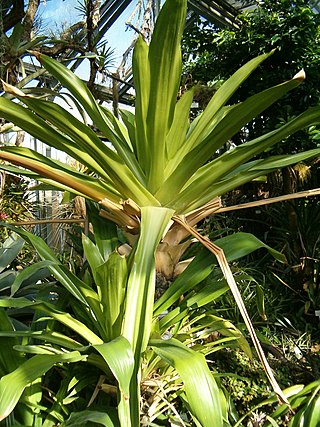
Brocchinia is a genus of the botanical family Bromeliaceae, and is the sole genus of the subfamily Brocchinioideae, containing 20 species. The genus is named for Giovanni Battista Brocchi, Italian naturalist (1772–1826). Brocchinia species are native primarily to the ancient Guayana Shield in southern Venezuela and Guyana, with some species extending into Colombia and northern Brazil. Its species are generally restricted to areas of sand and sandstone of the Roraima Formation; a few occur on granite.
Brocchinia uaipanensis is a species of bromeliad endemic to southern Venezuela. It has been treated as the sole species in the genus Ayensua under the synonym Ayensua uaipanensis, but Ayensua is now included in Brocchinia. The species was first described in 1957 by Bassett Maguire as Barbacenia uaipanensis.

Bromelioideae is a subfamily of the bromeliads (Bromeliaceae). This subfamily is the most diverse in the family, represented by the greatest number of genera with about 40. Most of the plants in this group are epiphytes, though some have evolved in, or will adapt to, terrestrial conditions. This subfamily features the most plant types which are commonly cultivated by people, including the pineapple.

Pitcairnioideae is a subfamily of the bromeliad family, Bromeliaceae. Traditionally, it was a large subfamily, comprising all those species with winged or more rarely naked seeds. Molecular phylogenetic studies showed that traditional Pitcairnioideae was not monophyletic, and the subfamily was more narrowly circumscribed. As of November 2022, the Encyclopaedia of Bromeliads placed five genera in the subfamily. Members of the subfamily are found from the Andes to the coast of Brazil, with one genus (Fosterella) found northwards to Mexico.
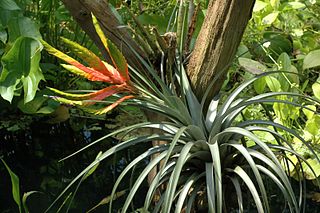
Tillandsioideae is a subfamily of plants in the bromeliad family Bromeliaceae. This subfamily contains the greatest number of species. Most are epiphytic or lithophytic, growing in trees or on rocks where they absorb water and nutrients from the air. Spanish moss of the genus Tillandsia is a well-known species. Bromeliads in the genera Guzmania and Vriesea are the more commonly cultivated members of this subfamily.
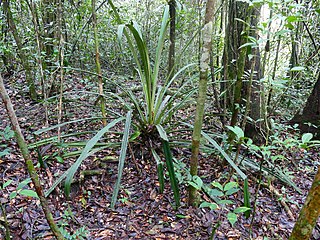
Disteganthus is a genus of plants in the family Bromeliaceae, subfamily Bromelioideae. The genus name is from the Greek “dis” (two), “steg” (covering), and “anthos” (flower). They are considered a primitive genus among bromeliads and are only found in terrestrial environments. Distenganthus has three known species, native to northeastern South America.
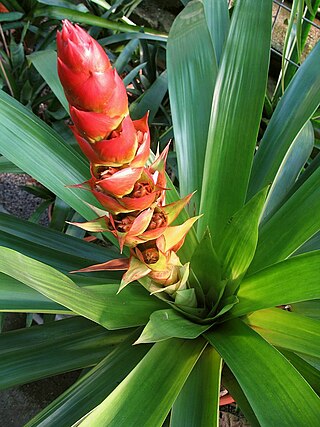
Mezobromelia is a genus of the botanical family Bromeliaceae, subfamily Tillandsioideae. The genus name is for Carl Christian Mez, German botanist (1866-1944). Some authorities treat Mezobromelia as a synonym of Cipuropsis.

Pitcairnia subg. Pepinia is a subgenus of plants in the family Bromeliaceae. It has at times been treated as the separate genus Pepinia, but is now included again in the genus Pitcairnia. The name is for Pierre Denis Pépin, French member of the Imperial and Central Society of Agriculture (c.1802-1876).
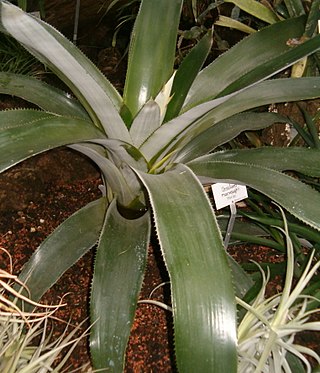
Ursulaea is a genus in the plant family Bromeliaceae, subfamily Bromelioideae. Some authorities treat Ursulaea as a synonym of Aechmea. There are two known species, both endemic to Mexico.
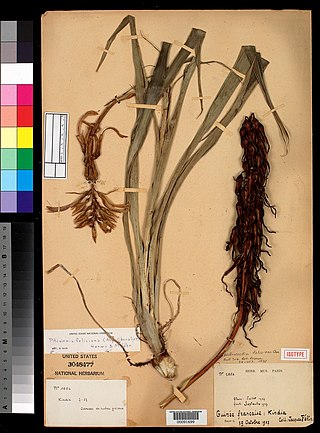
Pitcairnia feliciana is a plant endemic to central Guinea in West Africa and is the only species of bromeliad not native to the Americas. It can be found growing on sandstone outcrops (inselbergs) of the Fouta Djallon highlands in Middle Guinea.
Quesnelia blanda is a species of flowering plant in the family Bromeliaceae, endemic to southeastern Brazil. It was first described in 1856 as Bromelia blanda. As of November 2022, the Encyclopaedia of Bromeliads listed it under the synonym Quesnelia strobilospica, which it spelt Quesnelia strobilispica.
Vriesea warmingii is a species of flowering plant in the family Bromeliaceae, endemic to Brazil. As of November 2022, the species was accepted by the Encyclopaedia of Bromeliads, but regarded as a synonym of Vriesea ensiformis by Plants of the World Online.

Neoregelia schubertii is a flowering plant in the genus Neoregelia. The species is native to Brazil. As of November 2022, the Encyclopaedia of Bromeliads regarded it as a synonym of Neoregelia compacta.
Tillandsia rohdenardinii is a species of flowering plant in the family Bromeliaceae, native to south Brazil. It was first described by Teresia Strehl in 2004.
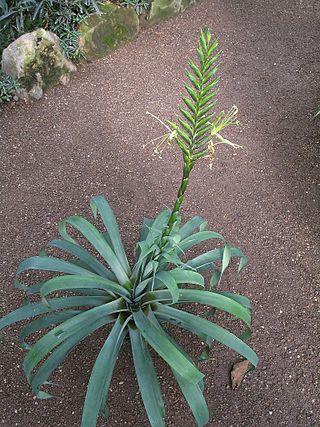
Pseudalcantarea viridiflora is a species of flowering plant in the family Bromeliaceae, native to Mexico and Central America. It was first described by Johann Georg Beer in 1856.
Josemania singularis, synonym Cipuropsis singularis, is a species of flowering plant in the family Bromeliaceae. This species is native to Costa Rica and Panama.

Navioideae is a subfamily of the bromeliad family, Bromeliaceae. It contains four or five genera, formerly placed in a more broadly defined subfamily Pitcairnioideae.

Rokautskyia is a genus of flowering plant in the family Bromeliaceae, native to eastern Brazil. The genus was first established in 2017, and is placed in subfamily Bromelioideae.

















